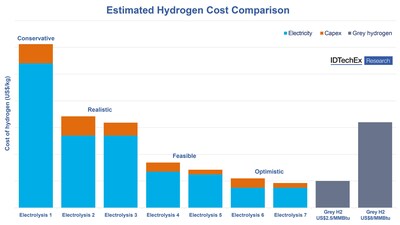BOSTON, March 17, 2023 /PRNewswire/ — The clean hydrogen market is poised for growth, driven by decarbonization efforts and concerns around energy security. A number of ambitious targets and roadmaps are being set out by different governments and regions. Clean hydrogen can refer to a number of routes for producing hydrogen, but the primary among them are green and blue hydrogen. Blue hydrogen refers to hydrogen produced from natural gas or coal but with carbon emissions captured. Green hydrogen refers to the splitting of water via electrolyzers powered by renewable power sources. IDTechEx forecasts that the water electrolyzer market will grow to over US$120B by 2033.
However, the key challenge for green and electrolytic hydrogen is cost. Green hydrogen is generally more expensive than grey, black, or even blue hydrogen due to the relatively low cost of natural gas and low energy use for hydrogen production. The Russia–Ukraine war led to increased natural gas prices across many regions of the world, leading Europe, in particular, to look at reducing its reliance on gas imports. Nevertheless, while this pushed the economic case for green hydrogen in the short term, the long-term cost competitiveness of green hydrogen is still debatable. The high electricity consumption and cost limit the widespread adoption of green or electrolytic hydrogen.
A reduction in the capital cost of electrolyzer systems, primarily for the electrolyzer stack itself, but also the balance of plant (such as the transformers, rectifiers, compressors, pumps, etc.) as well, will, of course, help to bring down the levelized cost of hydrogen. The industry expects capex to come down as manufacturing capacity increases and capabilities improve through greater levels of automation. Performance also has a significant impact. For example, the more efficient a system is, the lower the energy consumption. Solid-oxide electrolyzers are the most efficient type and can be improved further if waste heat can be utilized. Other key performance metrics for electrolyzer systems include operating lifetime, output pressure and purity, current and power density, start-up times, dynamic range, and minimum load levels.
Finally, the cost of electricity prices need to drop. At an electricity cost or price of around US$0.05/kWh, green hydrogen can start to become competitive with grey hydrogen on cost (given reasonable assumptions about electrolyzer capital cost and other operating costs). Levellized cost of energy for solar and onshore wind are starting to hit this price point, though this will not be everywhere, and further cost reductions would help strengthen the case for green hydrogen. However, this also highlights the need to utilize variable power sources, necessitating additional energy storage systems to smooth out the power supply or an electrolyzer system capable of operational flexibility. Currently, electrolyzer systems are generally better suited to operating at a steady state. This is particularly true for solid-oxide and, to a lesser extent, alkaline systems too. Polymer electrolyte membrane (PEM) systems are the best suited to dynamic operation and, as such, are starting to gain popularity over the more developed and lower-cost alkaline electrolyzer as a result. Innovations in electrolyzer systems also have a role to play. For example, new electrolyzer cell designs that separate gas directly in the cell, as being developed by Next Hydrogen Solutions, could help improve the dynamic operability of alkaline systems. Having an electrolyzer system capable and safe to operate at partial and variable loads will likely be key to the widespread success of green hydrogen.
The above highlights some of the challenges facing economically competitive green hydrogen production, though none of them are insurmountable. However, in the short-medium term, green hydrogen growth will likely remain reliant on government subsidies and incentives. Ultimately, green hydrogen can become cost-competitive, and the argument for electrolytic hydrogen, from a purely economic standpoint, will become stronger over the next ten years as electrolyzer systems become cheaper, their performance improves, and the cost of electricity comes down.
To find out more on electrolyzer technology, markets and players, please see the IDTechEx report “Green Hydrogen Production: Electrolyzer Markets 2023-2033“.
About IDTechEx
IDTechEx guides your strategic business decisions through its Research, Subscription and Consultancy products, helping you profit from emerging technologies. For more information, contact research@IDTechEx.com or visit www.IDTechEx.com.
Images Download:
https://www.dropbox.com/scl/fo/z0zer9r5oa6lxvzv17lkv/h?dl=0&rlkey=0ylvhdbue8ra30l8c60549590
Media Contact:
Lucy Rogers
Sales and Marketing Administrator
press@IDTechEx.com
+44(0)1223 812300
Social Media Links:
Twitter: www.twitter.com/IDTechEx
LinkedIn: www.linkedin.com/company/IDTechEx
Facebook: www.facebook.com/IDTechExResearch
Photo – https://mma.prnewswire.com/media/2034707/v2_Estimated.jpg
Logo – https://mma.prnewswire.com/media/478371/IDTechEx_Logo.jpg
![]() View original content to download multimedia:https://www.prnewswire.com/news-releases/green-hydrogen-idtechex-asks-if-it-can-be-cost-competitive-301774881.html
View original content to download multimedia:https://www.prnewswire.com/news-releases/green-hydrogen-idtechex-asks-if-it-can-be-cost-competitive-301774881.html
SOURCE IDTechEX



